When choosing a garage door, it's important to consider the appearance, material, construction, and method of operation (manual or automatic). Garage doors are usually either tilt-up or sectional roll-up. They are offered with flush, raised panel, or recessed panel designs. Your decision will depend on budget, design, and the structure of the garage itself -- you may need more than one door in a double garage.
Types of Garage Doors
Garage doors, traditionally made of wood, are now available in various materials. Steel and aluminum are commonly used, as is fiberglass. The latter is particularly popular, because it's lightweight, strong, and easy to maintain. Weight is an important consideration; a lightweight door is particularly desirable if it's large, or if an automatic system is being installed. If you plan to install doors yourself, even lightweight ones will be difficult to handle alone, so make sure you have help during installation. Also remember to think about your old doors. They aren't small items, and you may have arrangements for their disposal to make special
Automatic Door Openers
Today's garage-door openers offer photoelectric safety devices that reverse the door if an object breaks the light beam, door openers on key chains, openers with security codes, and electronic openers, which also operate lights and other electronic devices in the home. Electric garage openers also function as the garage lock, making it very difficult for an intruder to lift your door from the outside.
With all of the safety devices, one of the surprise frustrations electronic door openers bring is the inability to open during a power outage. Installing an emergency release kit on your garage door will enable you to open the door manually in the event that there is no power to operate it.
Materials
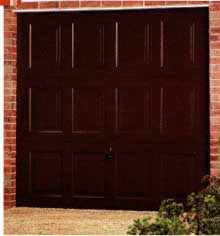
Steel tilt-up: Although not as light as fiberglass doors,
steel canopies still provide a relatively lightweight feel, and are
easy to open and close by hand.
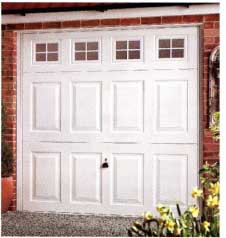
Fiberglass tilt-up: This type of door is made of lightweight
material, and has a pivot mechanism allowing for easy opening and closing
by hand.
Opening and Closing Mechanisms
Garage doors have a wide variety of opening and closing mechanisms. Some are similar to those used by other entrance doors, and some are used only with garage doors. Sectional (roll-up) garage doors are the most popular type offered. One-piece doors are typically less expensive, but require more headroom in the garage. These doors are often called tilt-up or swing-up doors. Almost any type of door can be automated (see figure).
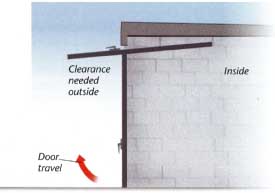
Tilt-up: canopy: Canopy tilt-up doors have a pivoting hinge
mechanism that allows the door to be lifted upward and slid back at
ceiling level into the garage. A portion of the base of the door protrudes
from the garage, providing a small overhang or “canopy.” This is the
simplest tilt-up mechanism, and the system is secured to the sides
of the frame, saving space.
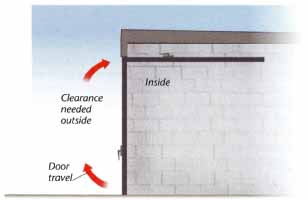
Tilt-up: retractable: A retractable tilt-up door operates
in much the same way as a canopy door, except that the door retracts
fully into the garage at ceiling level; it's suspended on a framework
independent of the door frame, and therefore occupies a little more
space than a canopy mechanism.
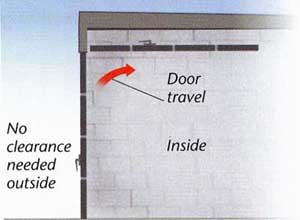
Sectional roll-up: Subdividing a door into four or more horizontal
sections provides the basic structure of a sectional garage door. The
divisions in the door allow it to roll straight up into a retracted
position so there is no need for door clearance outside the garage.
The sections slide through channels fixed to the doorframe, which keep
the door rigid when shut. Door travel; Inside; No clearance needed
outside.
Electric Door Operation
There are three basic types of electronic garage doors: screw drive, chain drive, and belt drive. Most electronic systems are based on a ceiling-mounted electric motor, linked to the door through a mechanism that pushes or pulls the door closed or opens it. Another type of system, called torsion, does not need a chain, belt, or screw. And unlike other systems, a torsion-operated garage door does not require the overhead tracks and ceiling-mounted box.
Some systems can be added to existing doors, in which case it may not be necessary to purchase a new door. However, there may still be a need to modify the opening mechanism of the existing door in order to incorporate an electric opener, so if you are adding the electric system retrospectively, take the time to choose a design of opener that best suits your existing door. The systems illustrated here are for use with tilt-up doors, but there are other types available that work equally well with side-opening doors.
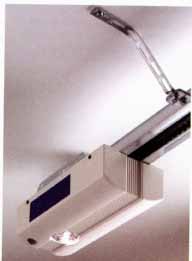
Motor: The motor is electrically operated and secured to
the ceiling. A belt or chain held in the rail mechanism connects the
motor with the door. Most motors are operated by remote control, and have safety devices that prevent the door from trying to close when
obstructed. A 1/2 hp motor should lift most typical garage doors.
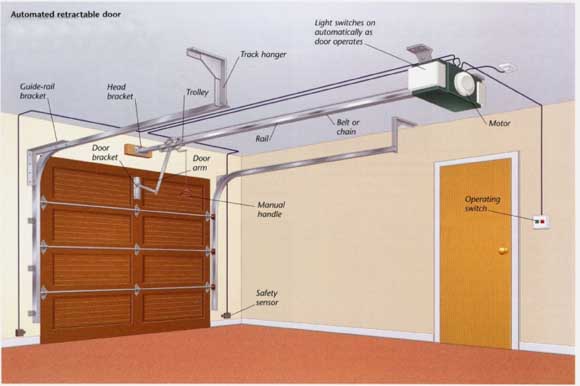
Automated retractable door: A typical installation for automating
this type of door involves a central rail with a motorized belt or
chain. This moves an arm, which in turn pulls the door up or pushes
it down. Light switches on automatically as door operates.
Maintaining Your Garage Door
Like anything you use everyday, you grow accustomed to counting on your garage door to function without problem. To keep your garage door running smoothly, tracks should be cleaned, rollers lubricated, and screws checked and tightened. Springs should not be rusty or have bulges. Also test your garage door’s reversing feature monthly to make sure it's operating safely. For more information about garage doors and safety, visit the International Doors Association at www.doors.org.